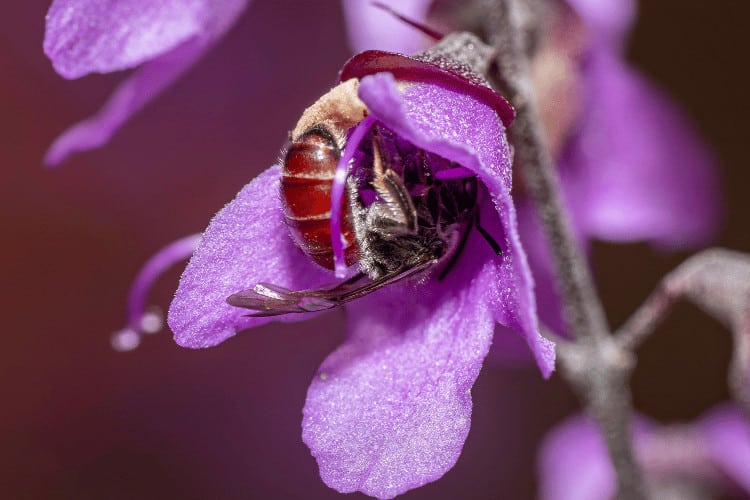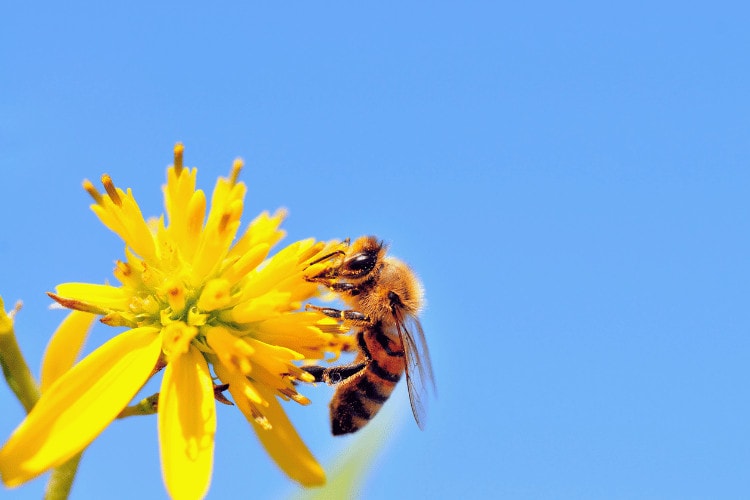Sweat Bees: All You Need to Know as an Aspiring Beekeeper
Have you ever been out for a run on a hot day and felt a bee land on your sweaty skin? If so, you’ve probably met a sweat bee. These small, metallic-colored bees are attracted to the salt and proteins in human sweat, which is how they got this funny name!There are over 4,000 species of sweat bees (the Halictidae family) all over the world. They come in various shapes and sizes, but most have one thing in common: they’re solitary bees.
If you’re interested in learning more about sweat bees, I encourage you to read on. In this article, we’ll take a closer look at these fascinating creatures. We’ll explore their physical characteristics, diet, habitat, behavior, and more.
Physical Description and Personality Characteristics of Sweat Bees

As a beekeeper, I’ve had the pleasure of getting to know sweat bees (or Halictid bees) quite well. Here are the most remarkable things to know about their looks and temperament.
Physical Appearance
While their appearance may slightly differ according to their variety, most of them share the following traits:
They’re often tiny, ranging in size from about 2 to 15 millimeters long, and they come in a variety of colors. These colors include metallic green, blue, and purple. Some sweat bees are also black or brown.
I’ve noticed that sweat bees have a few unique physical traits.
For one, they have short tongues, which they use to collect nectar from flowers. This makes them slightly less efficient pollinators than other bees, such as honeybees. Yet, it also means that they’re less likely to damage flowers!
Plus, sweat bees have pollen baskets on their hind legs, where they collect pollen to feed their young. These pollen baskets contain hairs that the bees use to comb the pollen off of flowers.
Character and Temperament
In terms of personality, you’d be delighted to know that sweat bees are relatively gentle. They’re not as likely to sting as other bees, like honeybees. However, they might sting if they feel threatened.
One of the things I find most interesting about sweat bees is their attraction to perspiration.
They’re drawn to the salt and proteins in sweat, which they lick to get these nutrients. This is why you’ll often see these bees buzzing around people in the summer!
What Is the Purpose of Keeping Sweat Bees?
In my experience keeping sweat bees for several years, I’ve come to appreciate their importance as pollinators.
They’re excellent pollinators of many plant species, including flowers, fruits, and vegetables. By keeping them, I can help ensure I have a bountiful harvest of everything from wildflowers and alfalfa to apples!
Plus, part of the reason I keep these bees is that I want to help them thrive. Sweat bees are declining in numbers due to habitat loss and climate change. So, it feels good to do the best that I can to ensure their survival.
Finally, I enjoy watching them!
Sweat bees are active and curious creatures. They love exploring their surroundings, and they’re always up for a new adventure.
Sweat Bee Habitat and Foraging Preferences
Sweat bees are found in a variety of habitats across the globe. For example, you may find them in meadows, forests, gardens, and even urban areas. They’re widespread over every continent except for Antarctica.
It makes sense, though, since they prefer open, sunny locations with plenty of blooms. But what are sweat bees looking for in a flower? It all comes down to scent and sugar content.
Sweat bees like flowers that have a strong scent and a lot of pollen. They’re also attracted to flowers that have a high sugar content, which gives them the energy they need to fly and pollinate.
Here are some of the factors that influence sweat bee habitat and foraging preferences:
- Climate: These bees like warm, sunny weather.
- Food availability: Sweat bees need access to flowers that have a lot of pollen and nectar.
- Nesting sites: Halictid bees require a safe place to nest, such as a hole in the ground or a cavity in a tree.
- Predators: Sweat bees are preyed upon by birds, spiders, and other insects.
Where Can You Find Sweat Bees in New Zealand?

Sweat bees are found all over New Zealand. They’re the most common type of bee in the country, with over 200 species you might be lucky enough to stumble upon.
Search in the following locations if you want to find sweat bees in their natural habitat:
- Gardens
- Meadows
- Forests
- Grasslands
- Urban areas
- Near flowers
- Near sources of water
- Near human activity
Sweet Bees Life Cycle, Mating, and Nesting
Sadly, sweat bees have a short life cycle, typically lasting only a few months.
The cycle begins in the spring when the female sweat bee emerges from her nest and begins to search for food and a mate.
Once she finds a mate, the female bee will lay her eggs in a hole in the ground or another cavity. The eggs hatch into larvae to feed on pollen and nectar. Then, the larvae pupate and emerge as adult sweat bees the following spring.
Most sweat bees are solitary creatures, so each female builds her own nest. However, from my observations, some bee varieties might display social behaviors.
Importance of Sweat Bees in Ecosystems and Agriculture
Pollination is the fertilization of a plant by the transfer of pollen from the male anther to the female stigma. This is essential for plant reproduction, as it allows plants to produce seeds.
Sweat bees are important pollinators because they’re efficient and effective. They can visit hundreds of flowers in a day and carry pollen over long distances.
As a result, you can’t miss their critical role in our country’s agriculture since they help pollinate crops such as apples, blueberries, and tomatoes.
In addition to their pollination services, sweat bees contribute to the decomposition of organic matter. They break down dead plants by feeding on parts of them, which then helps return nutrients to the soil.
Also, sweat bees are a crucial part of the ecosystem because they’re a food source for other animals and insects, such as birds and spiders.
Common Questions About Sweat Bees
Below, I’ll answer a few questions that may still be on your mind about these unique bees!
What do sweat bees eat?

Sweat bees are primarily nectarivores, meaning that a large percentage of their diet is made up of nectar. They also eat pollen and use it to feed their young.
Sweat bees will often feed on salt and proteins in sweat, too. However, sweat isn’t a major part of their diet.
Are sweat bees dangerous?
Sweat bees aren’t typically considered dangerous. They’re relatively docile and not as likely to sting as other types of bees.
In addition, they don’t sting humans for sweat; they’ll just lick it and go on their way. They’ll only sting if they feel threatened or if you accidentally swat them.
If a sweat bee stings you, the mild sting won’t be painful and will go away on its own within a few hours. However, if you have an allergic reaction to bee stings, you should seek medical attention immediately.
Here are some tips to avoid being stung by sweat bees:
- If you see a sweat bee on your skin, gently brush it away or leave it until it flies away on its own.
- Don’t wear bright colors or floral patterns.
- Avoid wearing perfumes or colognes.
- Always put on long sleeves and pants when you’re around the bees to keep yourself extra safe.
What size are sweat bees?
Sweat bees range in size from about 0.125 to 0.5 inches (3 to 15 millimeters) long. They’re typically smaller than honeybees and bumblebees.
Ultimately, the size of sweat bees can vary depending on the species.
How to identify sweat bees?
Here are some of the ways to identify sweat bees:
- Most sweat bees are usually metallic black, and they often have some yellow or orange markings.
- Sweat bees have four wings that are clear or translucent.
- The vast majority of this bee species has long legs.
- Sweat bees have a stinger.
How to attract sweat bees?
If you’re interested in attracting sweat bees as a beekeeping beginner, here are a few things you can do:
- Plant a wide variety of flowers that they like, such as lavender, mint, thyme, and clover.
- Leave some deadwood or other natural materials around for them to nest in.
- Avoid using pesticides or herbicides in your yard so as not to harm these delicate creatures.
To Wrap It All Up
Sweat bees are tiny but mighty pollinators that help keep our world green. They’re found in a variety of habitats, and they’re not as aggressive as other types of bees.
This makes them a fantastic choice for a beginner at beekeeping.
Now that you have all the information you need about sweat bees, you can approach your beekeeping adventure with more confidence!
